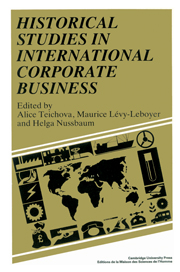Book contents
- Frontmatter
- Contents
- Preface
- 1 Introduction: multinational enterprise
- 2 History, the social sciences and economic ‘theory’, with special reference to multinational enterprise
- 3 The changing form of multinational enterprise expansion in the twentieth century
- 4 Electrical research, standardisation and the beginnings of the corporate economy
- 5 The nature of multinationals, 1870–1939
- 6 International price maintenance: control of commodity trade in the 1920s
- 7 Financial operations of US transnational corporations: development after the Second World War and recent tendencies
- 8 Multinational enterprise – financing, trade, diplomacy: the Swedish case
- 9 Foreign penetration of German enterprises after the First World War: the problem of Überfremdung
- 10 International industrial cartels, the state and politics: Great Britain between the wars
- 11 Vickers and Schneider: a comparison of new British and French multinational strategies 1916–26
- 12 J. & P. Coats Ltd in Poland
- 13 Multinationals and the French electrical industry, 1889–1940
- 14 The Japanese cotton spinners' direct investments into China before the Second World War
- 15 Mitsui Bussan during the 1920s
- 16 Japanese business in the United States before the Second World War: the case of Mitsui and Mitsubishi
- 17 The state and private enterprise in the United States–Latin American oil policy
- 18 Transnational corporations and the denationalization of the Latin American cigarette industry
- 19 Summary: Reflections on the papers and the debate on multinational enterprise: international finance, markets and governments in the twentieth century
- Index of names
- Index of firms
- Index of subjects
8 - Multinational enterprise – financing, trade, diplomacy: the Swedish case
Published online by Cambridge University Press: 04 August 2010
- Frontmatter
- Contents
- Preface
- 1 Introduction: multinational enterprise
- 2 History, the social sciences and economic ‘theory’, with special reference to multinational enterprise
- 3 The changing form of multinational enterprise expansion in the twentieth century
- 4 Electrical research, standardisation and the beginnings of the corporate economy
- 5 The nature of multinationals, 1870–1939
- 6 International price maintenance: control of commodity trade in the 1920s
- 7 Financial operations of US transnational corporations: development after the Second World War and recent tendencies
- 8 Multinational enterprise – financing, trade, diplomacy: the Swedish case
- 9 Foreign penetration of German enterprises after the First World War: the problem of Überfremdung
- 10 International industrial cartels, the state and politics: Great Britain between the wars
- 11 Vickers and Schneider: a comparison of new British and French multinational strategies 1916–26
- 12 J. & P. Coats Ltd in Poland
- 13 Multinationals and the French electrical industry, 1889–1940
- 14 The Japanese cotton spinners' direct investments into China before the Second World War
- 15 Mitsui Bussan during the 1920s
- 16 Japanese business in the United States before the Second World War: the case of Mitsui and Mitsubishi
- 17 The state and private enterprise in the United States–Latin American oil policy
- 18 Transnational corporations and the denationalization of the Latin American cigarette industry
- 19 Summary: Reflections on the papers and the debate on multinational enterprise: international finance, markets and governments in the twentieth century
- Index of names
- Index of firms
- Index of subjects
Summary
Introduction
Efforts to maintain political neutrality and economic independence are some of the basic, historically rooted features of Swedish foreign trade policy. Although situated in a remote corner of Europe and rather small in terms of population, Sweden has developed into a technologically sophisticated industrial country, particularly since the Second World War. Compared to home market sales the volume of Swedish foreign trade, always relatively large and decisively important for economic growth, has increased proportionately as Sweden's economy, like that of other industrial nations, has gone through a prolonged process of concentration. To what extent the degree of concentration is comparable to that of other countries is hard to judge, as a comparative study of the development of Swedish enterprises along the lines drawn up by Professor Alfred D. Chandler, Jr, has yet to be made. Still lacking, too, is a modern history of the banking economy. However, these gaps should be filled before long. The purpose of this paper is to provide some insight into the interrelations between the Swedish export economy and the major powers.
Sweden as a strategic component of the economies of the Great Powers
Obviously, sustaining neutrality and independence involves special problems. Thus the lack of coal on the part of neutral states during the First World War enabled Britain to pursue a stiff price policy. Her coal exports served as an argument for depressing the prices of vital British imports.
- Type
- Chapter
- Information
- Historical Studies in International Corporate Business , pp. 77 - 86Publisher: Cambridge University PressPrint publication year: 1989

